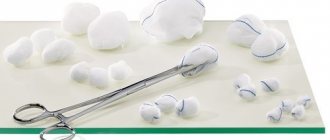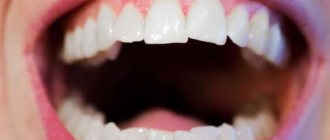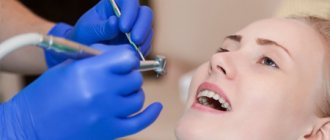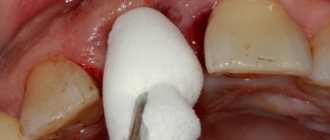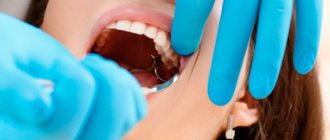Suturing the gums after tooth extraction: when required
On the eve of a surgical operation, patients are often interested in whether it is necessary to apply sutures after removing a tooth - wisdom, canine, incisor. There are certain indications for gum suturing:
- Dental implantation. When choosing a one-stage tooth restoration protocol, the patient must undergo two surgical interventions at once. This is tooth extraction and immediate implantation. In order for the dental implant to take root in the bone tissue without any problems, the doctor will apply sutures and leave the implant in the tooth socket.
- Removing eights. Wisdom teeth are characterized by enlarged roots, an uncomfortable position in the jaw row, and difficulty in extraction. When third molars are removed, soft and bone tissues are severely damaged, heavy bleeding begins, and severe pain is possible. To reduce unpleasant consequences, the doctor places a hemostatic sponge in the hole and sutures the gums after tooth extraction.
Sutures are also indicated when there is a threat of severe bleeding, extraction of dystopic and impacted teeth. The manipulation is also performed at the patient’s personal request.
In what cases does pain become a symptom of complications?
We found out how long a tooth should hurt after its removal and how long the recovery takes. But what to do if the symptom becomes more pronounced, the pain does not subside, and more than 5 days have passed since the procedure - complications have probably appeared. If the mucous membrane in the causative area is swollen and red, there is no blood clot in the hole and there are signs of suppuration, you need to urgently go to the doctor. Let's consider the main prerequisites for the development of complications.
Due to the fault of the dental surgeon
Sometimes problems arise due to the surgeon’s mistakes and shortcomings that were made during the procedure. Here are the most common medical errors that can lead to complications:
- burn of bone tissue during treatment with a drill - if the specialist does not use a handpiece with a supply of coolant, in most cases a thermal burn occurs, which can lead to the development of superficial necrosis and, accordingly, pain. In this case, it is better to immediately consult a doctor to undergo appropriate therapy,
- trauma to the mucous membrane by the sharp edges of the bone walls remaining after removal - if the interradicular bone septum is too high, its edges can protrude above the blood clot, injure the soft tissues of the oral cavity and provoke inflammatory processes,
- tooth fragments in the wound - an incompletely cleaned hole can also lead to tissue infection and the development of inflammation. To remove the fragments, you will need to see a doctor again,
- “dry socket” is the name given to a pathological phenomenon in which a blood clot is damaged or its formation does not occur at all. The reason may be the patient’s incorrect actions during the rehabilitation period, as well as incorrect technique for performing the procedure. For example, this happens if a specialist injects too much anesthetic with a component that causes vasospasm - a vasoconstrictor. This may prevent the formation of a protective clot and normal tissue healing,
- refusal to apply sutures - sometimes doctors decide that there is no particular need for sutures, even if for removal they needed to peel off a small area of the mucous membrane. If the situation is in doubt, it is better to apply at least one suture to avoid undesirable consequences,
- refusal of antibiotics - after extraction, a specialist usually prescribes antibiotics that prevent the spread of infection in injured tissues. If the doctor has not prescribed any medications, the risk of complications will increase many times over.
If the tongue constantly clings to sharp fragments of the tooth remaining in the sockets, a painful reaction to cold and hot liquid appears, the pain intensifies, the blood clot is not in its place, and the breath smells bad - you need to urgently consult a dentist. It is important to do this as quickly as possible in order to stop the pathological process at its very beginning.
Due to the development of the inflammatory process
When a blood clot is damaged, an inflammatory process often develops - the open wound becomes a fertile environment for the proliferation of bacteria and further infection of tissues. In this case, the pathological process may be accompanied by the release of pus from the socket, the appearance of an unpleasant odor, severe swelling and pain. This inflammatory complication is called alveolitis.
A similar situation can arise both through the fault of the surgeon and the patient himself. For this reason, it is extremely important to strictly follow all the specialist’s instructions during the rehabilitation period, do not rinse the mouth too intensely, avoid the vacuum effect, and eating too hard or viscous food. Treatment requires cleaning the hole from remnants of a blood clot and purulent masses, disinfecting tissues and putting anti-inflammatory medicine into the open wound.
Due to suppuration
Sometimes the blood clot in the wound becomes denser, but no signs of the inflammatory process appear. In such cases, symptoms usually occur indicating the formation of a hematoma and its suppuration:
- the appearance of asymmetry in the face, severe swelling of the gums and cheeks,
- elevated temperature,
- increased pain when touching the gum near the extracted tooth,
- tension of the mucous membrane over the source of suppuration,
- the appearance of cyanosis on the skin in the area of hematoma formation.
Such a nuisance may be associated with accidental damage to the vessel during the administration of anesthesia. At risk are patients with hypertension and diabetes mellitus, as well as those who took aspirin the day before. In this case, you need to go to the dentist - a specialist will cut the tumor, remove the pus and treat the wound with an antiseptic. It may be necessary to install a drainage system to drain purulent masses.
After complex extraction
If there is a complex tooth extraction, for example, an impacted and dystopic number eight, the doctor will need to make a fairly large incision on the mucous membrane, peel off a section of the gum in order to be able to easily remove the element. The procedure may take time, and the rehabilitation period may be complicated by severe symptoms.
“I had my wisdom tooth removed under sedation, because I was very afraid. And then, towards evening, the gums swollen so much that my cheek was swollen. I had to urgently go to the dentist. As it turned out, there was an abscess. Apparently the wound had festered. I had to cut the gum again, remove the pus, and treat it with antiseptics. Then everything took a long time to heal. I won’t delay things like this any longer and I don’t recommend you do so.”
Nina1987, Moscow, from correspondence on the forum www.32top.ru
Sometimes in such situations the development of an inflammatory process is observed. In this case, redness and swelling with a cyst or even an abscess of the jaw can be found in the area of the causative tooth. If the tumor is not removed immediately, it will provoke the release of pus, and this poses a danger to the entire body. In such situations, the doctor will have to remove the pus and disinfect the tissue, and possibly install drainage. All this requires additional surgical procedures, which prolongs the rehabilitation period. To prevent further spread of the infection, antibiotics must be prescribed.
Why did you sew up the hole after tooth extraction?
If stitches were applied after wisdom tooth removal, this will only be beneficial. Repeated studies have proven that a sutured socket is:
- reducing the risk of infection and complications - by 90%;
- rapid stop of bleeding;
- preservation of the blood clot and natural healing of the wound;
- minimal pain after surgery;
- rapid fusion of tissues thanks to sutures.
Sutures are placed on the socket immediately after the removal operation. After which the doctor gives recommendations for accelerated healing and rapid normalization of the general condition.
What not to do after suturing.
- don't rinse your mouth! Mouth baths in the first 3-5 days are more than enough;
- do not use hot compresses! This is fraught with the appearance of edema and the development of inflammation;
- do not create a vacuum in your mouth: do not puff out your cheeks, sneeze, blow your nose and spit very carefully;
- do not pick the wound, do not touch the clot with your tongue;
- do not drink or eat hot or cold food, only warm food;
- try to quit smoking for at least 2-3 days after surgery;
- Do not drink alcohol for 2-3 days - it does not promote tissue repair. Also rule it out if your doctor has prescribed a course of antibiotics;
- Do not overcool or overheat - give up sports exercises, swimming pools, saunas for 5-7 days.
Types of seams and suture materials
The patient’s further actions depend on what materials and suturing technique the surgeon used in dentistry. There are seams:
- Intermittent - stitches are applied separately, each secured with its own knot. Damage to one stitch does not affect the integrity of the others, allowing you to keep the hole closed.
- Continuous - all stitches are made with one suture thread and have a common knot. If one stitch is damaged, the entire seam comes apart.
Features of suture material:
- Absorbable threads are a sterile material of natural or synthetic composition, which after some time disintegrates into independent elements. During the healing process of the hole, the sutures securely fix the wound and then completely dissolve.
- Non-absorbable compounds are common synthetic threads used by dental surgeons in their work. These are polyester, nylon, silk, monofilament.
The material and features of suturing influence how the sutures are removed after the removal of a wisdom tooth or another unit.
Classification of seams
After tearing out the “eight”, at the discretion of the dental surgeon, regular and self-absorbing sutures can be applied.
In the first case, we are talking about materials that cannot dissolve on their own. These are silk, nylon, polyester. Such threads are not absorbed. They securely hold the edges of the wound until the doctor removes them. Self-absorbable material is absorbable. Its main advantage is that the patient does not have to visit the doctor again to have his stitches removed. The latter disappear without a trace on their own.
There are two types of self-absorbable threads:
- Absorbable due to hydrolysis reaction. These include Dexon and Vicryl threads. They are synthetic and do not cause allergic reactions. The edges of the wound are securely held for about one month.
- Absorbable due to the influence of enzymes. We are talking about Catgut. Its particles are quickly eliminated from the human body. Catgut is used for complex dental operations. But it is important to consider that it contains foreign proteins that can cause inflammation.
There is no need to think that suture materials dissolve without a trace. They simply break down into tiny particles that a person spits out or swallows. These particles are non-toxic and therefore cannot cause poisoning.
We sewed up the gum after tooth extraction: when to remove the sutures
Removal of sutures from the gums after tooth extraction is carried out 7-10 days after surgery. The doctor invites you to a follow-up appointment. When examining the patient’s oral cavity, the dentist notes the quality of wound healing and the general condition of the tissues in the area of the extracted tooth.
If healing goes well, the stitches will be removed on the same day.
How long does it take for sutures to dissolve after tooth extraction?
We sewed up the gum after tooth extraction - when the stitches dissolve depends on the material. There are many factors that determine the rate of natural destruction:
- composition - synthetic and natural;
- method of production of threads - what affects the breakdown of the composition;
- individual characteristics of the patient’s body - in particular the state of the immune system;
- the composition of saliva - destruction occurs under its influence.
There are approximate guidelines for when sutures dissolve after wisdom tooth removal, depending on the composition:
- 20-30 days - synthetic self-absorbing sutures after tooth extraction;
- 10-100 days - absorbable materials based on enzymes.
Features of the procedure
After the wound at the implant site has completely healed, the surgeon can begin to remove the threads. For the peace of mind of the doctor and the patient, it is recommended to do this with pain relief. Lidocaine-based drugs are most often used for this. Just surface treatment of the gums without injections is enough; gel formulas are ideal for this.
Even a doctor’s assistant can remove the stitches; there is nothing complicated in this procedure, and it takes no more than 5-10 minutes. First, the oral cavity is treated with an antimicrobial agent, and then an anesthetic is applied. The sutures are removed using small tweezers. At this time, the specialist can evaluate the result of the work he has done, and also make sure that there are no complications.
At the end of the procedure, a sterile bandage is applied to the surface of the gum, and the oral cavity is disinfected again. But even after the threads are removed, certain rules should be followed: do not eat too hot or cold food, alcohol, do not smoke and do not get involved in active sports. This is the only way the implant can take root as quickly as possible.
How to remove suture threads from a tooth socket
Many people associate the removal of sutures with unpleasant pain. Pain occurs only in people with a low pain threshold, increased sensitivity, or when there is inflammation in the tooth socket. Usually the patient experiences only discomfort.
Stages of removing suture material:
- treating the patient's oral cavity with an antiseptic;
- examination of the mucous membranes for hyperthermia, swelling, suppuration;
- the use of topical anesthesia to prevent even minimal pain;
- cutting the threads with a special dental instrument - the stitches are divided in half, especially in the case of an intermittent suture line;
- removing pieces of thread with tweezers;
- checking the density of the scar and the quality of wound healing.
Next, the patient will be asked to rinse his mouth with an antiseptic composition.
The first three days after the stitches are removed, stiffness of movements and discomfort when opening the mouth are possible.
Before surgery, it is necessary to carry out professional oral hygiene.
If the operation is performed with an anesthesiologist, you must come with an accompanying person, or the operation will be cancelled.
Recommendations for surgical treatment
After surgery, you may experience pain, which will go away as the tissue heals. Postoperative swelling or hematoma can also occur in areas adjacent to the surgical site, which is a natural consequence of surgery. There may be a slight increase in body temperature.
Please follow our recommendations!
Why do the sutures hurt after tooth extraction?
Unpleasant sensations accompany patients during the first hours after tooth extraction. Traumatic surgery requires some time for the body to recover. When the hole is sutured, the rehabilitation process goes faster, but complications also occur.
Alarming symptoms that require consultation with a doctor are as follows:
- bleeding - unexpectedly resumed or continues for more than a day;
- increasing pain - throbbing, radiating to the ear or neck, interfering with sleep and leading a normal lifestyle;
- growing swelling - of soft tissues in the oral cavity or even on the face from the side of the extracted tooth;
- redness and hyperthermia in the surgical area;
- saliva with blood - even several hours after removal;
- high temperature, weakness, general malaise.
Only the attending physician can understand what exactly is happening and what is the reason for feeling unwell. Therefore, at the first sign of discomfort, you need to call the clinic and make an appointment with a doctor.
Useful tips for oral care
- hold the cotton swab applied by the doctor for 20-30 minutes;
- within 2-3 hours after surgery, be sure to apply cold compresses to reduce tissue swelling;
- carry out oral baths (not to be confused with rinsing) with antiseptic drugs for 3-5 days: “Miramistin”, “Chlorhexidine 0.5%” or other drugs prescribed by a doctor can be used as medicinal solutions;
- after 3-5 days, start using a toothbrush - only a soft one for the operated area, as well as a new one, without bacteria on it. The teeth of the opposite jaw can be brushed immediately, the main thing is to avoid the area of the extracted tooth;
- chew food on the side opposite the injured area;
- You can drink water immediately, preferably warm;
- You can eat only after the anesthesia wears off, that is, after 2-3 hours;
- Lead a quiet lifestyle, try to avoid physical activity and heavy lifting for 5-7 days.
Oral hygiene
Regardless of the size or number of implants, they must be cared for as if they were regular teeth. Brush and floss your dental implants twice a day. Use special fluffy dental floss (for example, Oral-B superfloss or ultrafloss).
When brushing your teeth, pay special attention to the back teeth and between teeth. Use a soft or medium-hard brush. In addition, use an irrigator for additional deep cleaning of the interdental spaces with water irrigation.
There are special brushes that can be used to clean interdental spaces - dental brushes. Ask your dentist about them - in some cases they are not recommended.
Visit your dental hygienist twice a year; they are the only ones who can clean your implants as thoroughly as necessary. Regular visits to the dentist are very important. Your dentist will check the condition of your gums, jaws and implants.
Smoking is bad for your health and for dental implants, too. To have a good prognosis for the lifespan of your implants, it would be a good idea if you stopped smoking.
Before surgery:
Prepare several days off after the date of the planned operation.
Do not smoke or reduce the number of cigarettes you smoke.
If you are sick on the eve of the operation, please notify the implantologist.
Ask your implantologist about the medications you will need immediately after surgery.
Patients suffering from compensated diabetes mellitus must follow a strict diet 2 weeks before surgery and 2 weeks after it.
Get a good night's sleep the night before surgery.
Make sure you are accompanied if you plan to undergo anesthesia, sedation or a complex operation, do not plan to be behind the wheel.
If you have herpetic rashes on the mucous membrane, the operation should be rescheduled.
Eating
Avoid chewing hard candy, ice, or other hard foods (such as hard chocolate or dry fish) as they may loosen or break the abutment screw.
Avoid foods such as caramel or toffee, as they may stick to the crown and cause the abutment screw to loosen.
Do not open bottles or crack nuts with your teeth for the same reasons.
Wear protective sports mouth guards when participating in sports and avoid direct blows to the face.
Refrain from grinding your teeth. If creaking occurs unintentionally or during sleep (bruxism), notify your dentist and he will make you a thin night guard.
The length of their service depends on the quality and regularity of care for implants.
Before and after implantation
